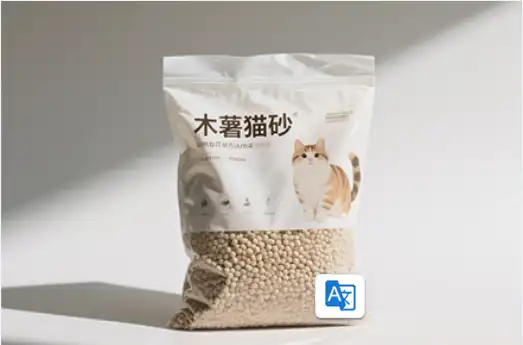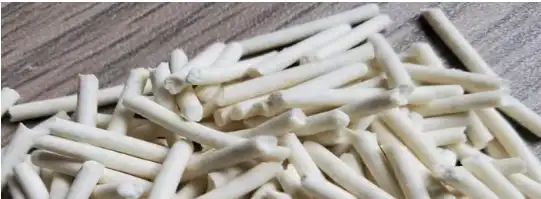How Often Should You Change Corn and Cassava Cat Litter for Freshness
2025-09-05How Often Should You Change Corn and Cassava Cat Litter for Freshness
Corn and cassava cat litter offer eco-friendly alternatives to clay-based options, providing excellent odor control and easy maintenance. This article explores their unique benefits, ideal changing schedules, and how factors like humidity affect performance. Learn how Fat Cat’s high-quality, natural litters ensure pet safety and simplify cleanup for a fresher home.

What Makes Corn and Cassava Cat Litter Different from Traditional Options?
Common clay-based cat litters, often chosen for their ability to clump and manage smells, come with a downside. They harm the environment because they rely on mining that can’t be renewed and don’t break down naturally. On the other hand, corn and cassava cat litter stand out as a greener choice. They’re made from natural stuff and work in a way that’s kinder to the planet.
Tofu cat litter comes from plant fibers like leftover tofu bits. It’s super friendly to the environment since it breaks down easily and doesn’t harm nature. The main materials include things like corn powder, pea bits, starch, and a natural binder called guar gum. These safe, food-quality components make it okay to flush down the toilet and simple to tidy up. Plus, being free of dust and non-toxic, tofu litter poses no risk to people or cats.

How Frequently Should You Replace the Entire Litter Box?
How often you need to swap out your cat’s whole litter box depends on what kind of litter you’re using. For corn-based tofu litters, the rule is to scoop out waste every day and do a full swap every two weeks. This keeps things clean for your pet while saving money by not wasting too much.
Cassava cat litter lasts even longer. You can do a complete change just once every four weeks. Its quick clumping and awesome ability to hold moisture make this possible.
Stick to these timelines, and you’ll keep your cat’s space fresh without throwing away more than needed or spending extra cash.
Can Daily Scooping Extend the Life of Your Litter?
For sure! Scooping every day is a must, no matter if you use corn or cassava-based litters. The advice is clear—clean it out daily, and this applies to both kinds.
Getting rid of solid messes and wet clumps each day stops bad smells from building up. It also keeps germs at bay. On top of that, the clean litter left behind stays usable for a longer time. The starch in these granules soaks up liquid fast, turning it into tight clumps. Smells get locked inside, so your home stays fresh.
Following this habit cuts down on waste. It also boosts how well top-notch litters like corn or cassava work for you.
What Are Signs That It’s Time to Change the Litter Sooner?
Even with great stuff like corn and cassava cat litter, sometimes you might need to change it all out before the usual time.
Cats are picky and often show they’re unhappy in quiet ways. If your kitty starts dodging the box or going elsewhere, that’s a hint it’s time for a fresh batch.
Other clues are smells that won’t go away even after daily scooping. You might also notice the leftover litter looking off-color. Sure, both tofu and cassava litters are awesome at fighting odors—they can clump in just 3 seconds and trap smells—but they still have limits. Heavy use or stuffy rooms can push them past their best.
Keep an eye on your pet’s behavior. That’ll help you figure out when to swap things out early for their comfort and cleanliness.
How Does Humidity or Season Affect Your Changing Schedule?
The weather and air around you can really change how often you should refresh your cat’s litter. Damp air speeds up germ growth and messes with smell control, even in top products like cassava or tofu-based litters.
These litters are made to keep dust super low, with a rate under 0.13% thanks to a thorough dust-removal process. That’s better than many mineral-based sands. This helps keep the air clean in dry times. But in wet, humid areas, too much moisture can make it less effective over time.
Seasons matter too. They can change how much water your cat drinks. In hot months, more pee might end up in the box, so you’ll need to check it more often.
Tweak your swap-out plan based on the weather. That way, your litter will work its best all year long.
Why Is Choosing High-Quality Cassava Litter Important for Maintenance?
Not every cassava litter is the same. The better ones have clear perks that make cleaning and overall use a lot easier.
Top-notch cassava litter is made from food-safe starch and passes strict safety checks, like having zero harmful chemicals. It’s low-risk even if a pet accidentally eats a bit, which is great for kittens or cats with sensitive systems. This gives peace of mind, especially in homes with lots of pets or little ones who might touch it often.
Also, the best kinds don’t stick much. Just a thin 2cm layer keeps the bottom of the box neat. This cuts down on cleaning hassles and lets you use it longer before a full change.
Spending on good quality saves you trouble later. It helps with smell control, easy scooping, and keeping things tidy overall.
Does Flushing Used Cassava Litter Help With Waste Disposal?
One big plus of corn (tofu) and cassava-based litters is that you can flush them. That’s something you can’t do with old-style clay litters.
The best part? You can toss it right into the toilet for easy handling. Small clumps can go down the drain without trouble. Just don’t flush big amounts at once to avoid clogging your pipes.
This green way of getting rid of waste cuts down on what goes to landfills. It’s handy for city folks who don’t have easy outdoor trash options. But always double-check local rules before flushing pet waste down your pipes.
Flushing small bits safely boosts eco-friendliness while keeping your home clean and sanitary.
How Do You Choose a Product That Combines Performance With Safety?
When picking from the many corn and cassava cat litters out there, focus on things that keep your cat healthy and make life easier for you. Here are some tips:
-
Go for food-safe materials: Look for stuff like all-natural corn flour, pea bits, starch, and guar gum.
-
Pick something gentle on allergies: Tapioca is safe, non-toxic, and free of harsh stuff like clay, silica, or fake smells.
-
Make sure it’s low-dust: Check for a dust rate below 0.13%, thanks to a full dust-control process.
-
Check how fast it clumps: It should bunch up in just 5 seconds when it gets wet.
These points help you find a litter that works well, keeps your pet safe, and makes daily care simpler for you too.
FAQ
Q1: Can I mix tofu (corn) litter with cassava litter?
A: You can, since both come from plants. But mixing might mess with how well they clump or control smells, depending on how much of each you use.
Q2: Is either type suitable for kittens?
A: Yes. They’re safe for kittens and pets with sensitive needs.
Q3: Will switching between brands upset my cat?
A: Cats like routine. If you’re changing to a new texture or smell—even between natural ones like corn-based tofu or cassava (tapioca) kinds—do it slowly over a few days.


